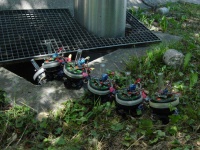|
Ongoing projects
|

|
E-SWARM: Engineering Swarm Intelligence Systems.
E-SWARM is a project funded by the European Research Council - Advanced Grants program of the European Union (Grant 246939).
The main case studies have been chosen in the domains of optimization and robotics. In the robotics case study,
we study the use of swarm intelligence as a tool to develop controllers for swarms of cooperating robots.
The principles of swarm intelligence are employed in swarm robotics for the design of robot controllers at the
individual level so as to obtain effective swarm-level behavioral strategies. We will focus on swarm behaviors
characterized by the coordination and cooperation of the members of a group of robots to accomplish tasks that
are beyond the capabilities of a single robot.
|
|

|
H2SWARM: Hierarchical Heterogeneous Swarm.
The main goal of the project is the study of hierarchical communication and control strategies for swarms of
heterogeneous robots, which, despite the differences among sub-groups, coherently operate in an integrated
manner to achieve a common goal. This will be achieved by looking at how Nature structures and organises large
groups, such as ant colonies or honeybee swarms. Natural systems are characterised by different types of
hierarchical organisation (physical, spatial, functional, informational) which evolved to be tightly integrated
and to ensure the survival of the system as a single unit. The H2SWARM project aims at studying the evolution of
cooperative behaviours in hierarchical heterogeneous organisations, and the mechanisms that support hierarchical
organisations in social insects.
|
|

|
ASCENS: Autonomic Service-Component Ensebles.
Self-aware, self-adaptive and self-expressive autonomic components, running within environments which are called
“ensemblesâ€, have been proposed to handle open-ended, highly parallel, massively distributed systems that can span
millions of nodes with complex interactions and behaviours. However, these complex systems are currently difficult
to develop, deploy, and manage. The goal of the ASCENS project is to build ensembles in a way that combines the
maturity and wide applicability of traditional software engineering approaches with the assurance about functional
and non-functional properties provided by formal methods and the flexibility, low management overhead, and optimal
utilization of resources promised by autonomic, adaptive, self-aware systems.
|
|
Past projects
|

|
Swarmanoid: Towards Humanoid Robotic Swarms.
The Swarmanoid project proposes a highly innovative way to build robots that can successfully and adaptively act
in human made environments. The Swarmanoid project will be the first to study how to design, realise and control
a heterogeneous swarm robotic system capable of operating in a fully 3-dimensional environment.
The main scientific objective of the proposed research is the design, implementation and control of a novel
distributed robotic system comprising heterogeneous, dynamically connected small autonomous robots so as to form
what we call a swarmanoid. The swarmanoid that we intend to build will be comprised of numerous (about 60)
autonomous robots of three types: eye-bots, hand-bots, and foot-bots.
|
|

|
Swarmanoid: Towards Humanoid Robotic Swarms.
The main scientific objective of the Swarm-bots project is to study a novel approach to the design and
implementation of self-organising and self-assembling artefacts. This novel approach finds its theoretical roots
in recent studies in swarm intelligence, that is, in studies of the self-organising and self-assembling capabilities
shown by social insects and other animal societies. The main tangible objective of the project is the demonstration
of the approach by means of the construction of at least one of such artefact. We intend to construct a swarm-bot.
That is, an artefact composed of a number of simpler, insect-like, robots(s-bots), built out of relatively cheap
components, capable of self-assembling and self-organising to adapt to its environment.
|
|
|